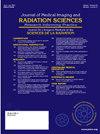Pan-Canadian Assessment of Image Guided Adaptive Radiation Therapy and the Role of the Radiation Therapist
IF 2
Q3 RADIOLOGY, NUCLEAR MEDICINE & MEDICAL IMAGING
Journal of Medical Imaging and Radiation Sciences
Pub Date : 2025-05-01
DOI:10.1016/j.jmir.2025.101926
引用次数: 0
Abstract
Purpose/Aim
Adaptive radiation therapy (ART) is a close-looped process where anatomic changes observed during treatment are identified, leading to plan modification prior to treatment delivery. With technological advances, ART is increasingly used in clinical practice, involving offline modifications between treatment fractions and real-time online adjustments. This study aims to assess ART practices across Canada and explore how these technologies affect the roles and responsibilities of Canadian Radiation Therapists (RTTs).
Methods/Process
A 30-question survey was emailed to RTT managers at all cancer centers in Canada (n=48). The questions covered center demographics, the presence of offline and/or online ART activities as standard care, roles and responsibilities of the multidisciplinary team, and training activities. Prior to distribution, the questionnaire was piloted for clarity and face validity by four RTTs with expert knowledge of the ART process. The survey was administered electronically and remained open for three weeks. Responses were analyzed using descriptive statistics.
Results or Benefits/Challenges
Thirty-two of 48 centers (67%) responded, representing all ten provinces. Of these, 25 centers (78%) practice ART, with all implementing offline ART and five also using online ART. Among the centers using offline ART, the brain was the least commonly treated site (56%), while head and neck treatments were adapted in almost all centers (except one). Five centers (16%) reported daily online ART, primarily for prostate patients, though brain, upper GI, and lower GI treatments were also adapted in some centers. The most common barriers to ART implementation were technical limitations and lack of resources. RTTs were responsible for 50% of offline ART tasks and 58% of online ART tasks, with the most significant change being the inclusion of target delineation in their daily responsibilities.
Conclusions/Impact
ART adoption varies across Canada, with offline ART more widely practiced than online ART, which is limited by technical and resource constraints. As centers adopt online ART, the roles of RTTs will need to evolve, focusing on upskilling to meet the demands of this emerging treatment paradigm.
泛加拿大评估图像引导的适应性放射治疗和放射治疗师的作用
目的/目的适应性放射治疗(ART)是一个闭环过程,在治疗过程中观察到的解剖变化被识别出来,导致在治疗交付之前修改计划。随着技术的进步,ART越来越多地应用于临床实践,涉及治疗组分之间的离线修改和实时在线调整。本研究旨在评估加拿大各地的ART实践,并探讨这些技术如何影响加拿大放射治疗师(rtt)的角色和责任。方法/过程通过电子邮件向加拿大所有癌症中心的RTT经理(n=48)发送30个问题的调查。问题包括中心人口统计、作为标准治疗的线下和/或在线ART活动的存在、多学科团队的角色和责任以及培训活动。在分发之前,问卷由四位具有抗逆转录病毒治疗过程专业知识的rtt进行了清晰度和面效度试验。该调查以电子方式进行,开放时间为三周。采用描述性统计对反馈进行分析。 结果或利益/挑战48个中心中有32个(67%)做出了回应,代表了所有10个省。其中,25个中心(78%)实施ART,所有中心都实施线下ART, 5个中心也使用在线ART。在使用离线ART的中心中,大脑是最不常接受治疗的部位(56%),而头颈部治疗在几乎所有中心都适用(除了一个)。五个中心(16%)报告每日在线ART,主要用于前列腺患者,尽管一些中心也采用脑、上消化道和下消化道治疗。实施抗逆转录病毒治疗的最常见障碍是技术限制和缺乏资源。rtt负责50%的离线ART任务和58%的在线ART任务,最显著的变化是将目标描述纳入其日常职责。结论/影响ART的采用在加拿大各地有所不同,由于技术和资源的限制,线下ART比在线ART更广泛。随着各中心采用在线ART, rtt的角色将需要发展,重点是提高技能,以满足这种新兴治疗模式的需求。
本文章由计算机程序翻译,如有差异,请以英文原文为准。
求助全文
约1分钟内获得全文
求助全文
来源期刊

Journal of Medical Imaging and Radiation Sciences
RADIOLOGY, NUCLEAR MEDICINE & MEDICAL IMAGING-
CiteScore
2.30
自引率
11.10%
发文量
231
审稿时长
53 days
期刊介绍:
Journal of Medical Imaging and Radiation Sciences is the official peer-reviewed journal of the Canadian Association of Medical Radiation Technologists. This journal is published four times a year and is circulated to approximately 11,000 medical radiation technologists, libraries and radiology departments throughout Canada, the United States and overseas. The Journal publishes articles on recent research, new technology and techniques, professional practices, technologists viewpoints as well as relevant book reviews.
 求助内容:
求助内容: 应助结果提醒方式:
应助结果提醒方式:


